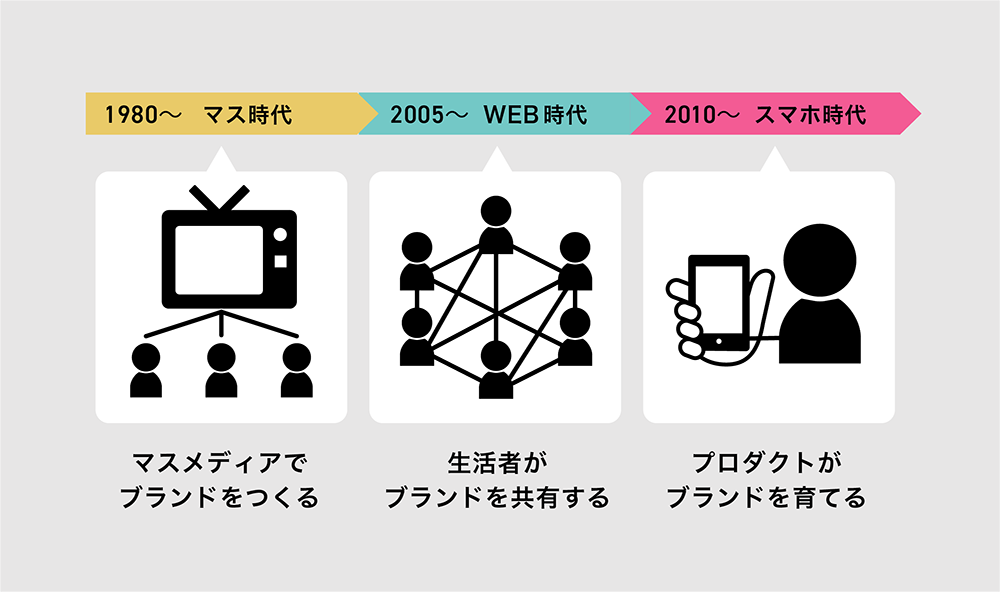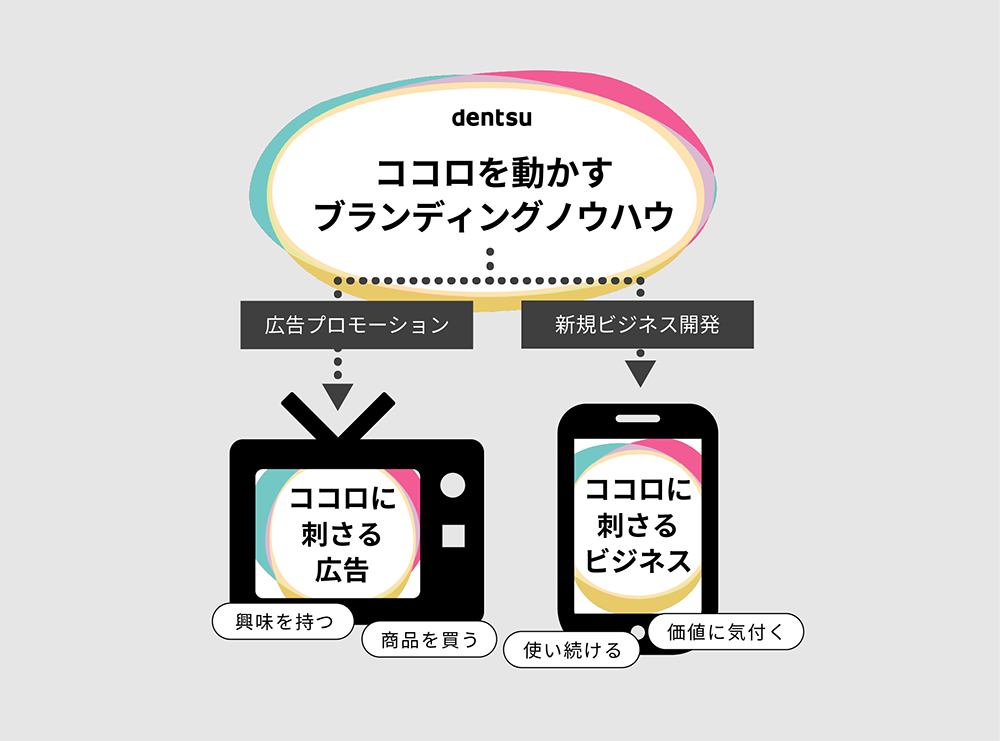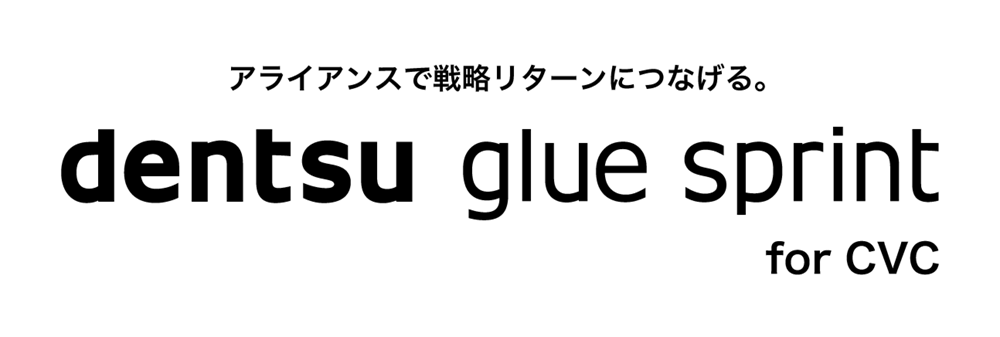Note: This website was automatically translated, so some terms or nuances may not be completely accurate.
Embed "Self-Sustaining Branding" into Your Products!
Where is the most suitable place for companies to conduct branding for consumers?
Today, consumers constantly interact with companies daily through products and services like smartphone apps. This means the "experience" of these daily products and services themselves become crucial branding opportunities for companies.
In this article, Makishima, an experience designer and creative technologist who supports various companies' businesses, will introduce how branding platforms have evolved and the skills needed to "embed" branding within products.
Through smartphones, companies and consumers communicate daily
First, let's confirm how the "branding arena" has gradually changed over time. Please look at the diagram below.

In the past, simply airing brand commercials on television, which everyone watched, was enough to permeate the world with a company's brand image.
Next, as technology advanced, we entered the era of the web and social media, where infrastructure for consumers to exchange information with each other became established. Authentic, raw user voices increasingly became the deciding factor in consumer behavior.
The words spoken by companies were overwritten by the words spoken by users who actually purchased the products, and the brand image felt by consumers began to be shared among consumers themselves. Naturally, companies also keenly sensed this shift, leading to active experimentation with branding through web videos and social media.
Then, with the proliferation of smartphones enabling anyone to easily share information, the focus shifted to smartphone-mediated experiences after 2010, a period marked by accelerating information explosion.
Thus, we entered an era where services offering higher satisfaction and better usability are chosen as partners in daily life. Many people now have corporate products installed on their smartphones in the form of apps.
We now interact with companies and brands in the palm of our hands on a daily basis. What this article aims to convey is branding through these "products."
Is "branding" being formed on apps!?
Amazon, LINE, Twitter, Rakuten Ichiba, TikTok, YouTube, Discord, Instagram, Uber Eats, manga apps, news apps, and more.
In our daily lives, it's safe to say that direct contact with "services provided by companies" themselves has become the highest in both quality and quantity.
Furthermore, even companies traditionally focused on "selling goods" are shifting their business models. Many now use apps to let users experience services (experiences) and generate revenue through long-term communication.
In this environment, the impressions consumers form from their daily interactions with services become their reality.
Of course, branding hasn't completely shifted to smartphones. Mass media has its strengths, and social media has its own.
For example, in a 15-second commercial slot, it's best to appeal with concise, essential words and matching catchy visuals.
Conversely, on social media where consumers interact, it's effective to include stories that naturally prompt comments or sharing.
And in the world where the smartphone screen and the consumer face each other one-on-one, the product's functionality and experience itself must embody the brand's philosophy and, moreover, be something truly good for the consumer.
The key to self-sustaining branding lies in the land of dreams
To summarize what we've discussed so far:
- In the smartphone era, companies and consumers engage in daily dialogue through products (apps and services).
- The ideal is for the brand's vision, the service's mission, and the company's core message to be felt within the service experience.
In essence, this requires "self-sustaining branding" driven by the product itself.
Suddenly, but Disneyland is, of course, the land of dreams. It's a well-known fact that Disneyland is designed so that surrounding buildings are invisible from within the park. They also completely eliminate trash to prevent crows from entering the park.
While these are just a few examples, Disneyland achieves its "land of dreams" by meticulously eliminating any "moments that bring you back to reality." Guests remain immersed in the dream as long as they stay within the park.
If we consider Disneyland as a single "product," then the product's very design embodies the "land of dreams."
In other words, if a product embodies the brand's philosophy and vision, as long as people experience it, it continuously delivers the equivalent effect of free, automatic branding advertising.
Couldn't we think about smartphone apps and web services in the same way as Disneyland?
Consider Twitter as a concrete example of an app/web service we interact with daily via smartphones. As its slogan "What's happening?" suggests, Twitter is a service that lets you instantly share what's happening right now with the world. The Twitter product is designed to embody this philosophy.
For instance, the "140-character" limit creates a sense of speed for posting and viewing timelines. Unlike the blogs that were gaining prominence at the time, the rapidly scrolling "timeline" is designed so that older information doesn't catch your eye.
As a result, users unconsciously came to recognize Twitter as a highly real-time information sharing service, establishing a unique SNS brand distinct from other information sharing services.
This wasn't accidental. They understood their brand's value and intentionally incorporated design choices—like limiting functionality and discarding unnecessary information—into their service architecture.
In today's smartphone era and service-driven age, this clearly demonstrates how crucial product development focused on "self-sustaining branding" truly is.
The perspective of brand design—thinking "If we create this product with this vision, this UX will make users feel the brand"—is essential for product development.

What are the pitfalls of business development and service development?
However, in many cases, there is a disconnect between the vision and worldview a brand holds and the actual product, such as a smartphone app.
Consideration often falls short on questions like: How should each function and design element be shaped to embody the brand's worldview? What constitutes the correct design form that effectively communicates the brand's vision?
This happens because when companies develop new services, they inevitably lean too heavily toward the business perspective. They tend to focus primarily on implementing features. What's truly needed is careful design centered on the brand experience we want consumers to have when they interact with and use the product.
Another pitfall is when the people defining the brand vision and those developing the product are separate. Development staff often focus solely on business and functionality, leading to situations where the brand's value isn't reflected in the actual product.
To embed "self-sustaining branding" into a product, you need a brand design expert. Crucially, this expert must join the team early in business or service development and work alongside them throughout.
But what specific skills does brand design entail?
Media may change, but human nature remains constant!
As discussed, in an era where companies and consumers are constantly connected, branding must extend to customer touchpoints like "products encountered daily."
That said, the fundamental approach to branding doesn't change. The essence of the human audience remains constant.
Whether in analog spaces or on social media, people feel happy when praised, experience a sense of accomplishment when their efforts pay off, are moved by human warmth, and get angry when they feel discomfort. The mechanisms that move the "human heart" have remained unchanged for thousands of years.
This means that branding skills honed through TV commercials and social media are equally applicable to product development. We must now apply the "essence of branding" to product development itself.

To achieve "self-sustaining branding," we must involve creative members who are experts in brand design from the very planning and development stages of the business. This ensures that the product and the experience it delivers can shape the brand through experience design and functional design.
This spans from formulating brand statements and mission/vision statements to envisioning ideal experiences—like imagining the UX needed to create a service aligned with a specific vision.
Whether moving the hearts of people watching TV or those using smartphones—while the media may differ, human nature remains constant. This is precisely why "branding skills that move people" become vital in product development.
Incorporating a branding perspective into product development completely transforms the business!
Heart-moving branding works in every aspect of business development. For example, by making the brand's identity and vision compelling and clear,
- aligns the perspectives of all stakeholders.
- Presentations to investors and upper management become more impactful.
- It clarifies which features to implement and what not to pursue.
- It also clarifies the user experience story—what you want users to experience.
These effects can be expected, giving business development greater momentum than ever before.
On the other hand, products that incorporate brand philosophy make their value clear to consumers. The more they use them, the stronger their bond with the company becomes. And the stronger that bond, the more the service grows.
Now, a little bit of promotion!
Dentsu Inc. has launched 'Dentsu Group Sprint for CVC,' a service that creatively shapes collaborations between operating companies and startups, as well as new business creation.
This service targets CVCs (Corporate Venture Capital) and business division personnel. Recently, many face challenges in successfully advancing collaborations when developing new businesses with startups. "Dentsu Inc. Group Sprint" provides creative services for successful collaboration, from formulating alliance visions and brand development to designing products that incorporate "self-sustaining branding."
Consistent product creation from brand to experience. From this perspective, we take pride in being a company that can provide business development support fit for today's era, precisely because Dentsu Inc. has always designed brands with a holistic view—from vision formulation to the point where the product reaches the user.

Why not leverage Dentsu Inc.'s cultivated "branding skills that move people's hearts" not just in advertising, but in business development? Please consult with Dentsu Group Sprint!

Was this article helpful?
Newsletter registration is here
We select and publish important news every day
For inquiries about this article
Author

Makishima
Dentsu Inc.
BX Creative Center
Experience Designer and Creative Technologist
We provide comprehensive creative support encompassing the business layer, including UI/UX consulting, service concept design, and brand and vision development.

